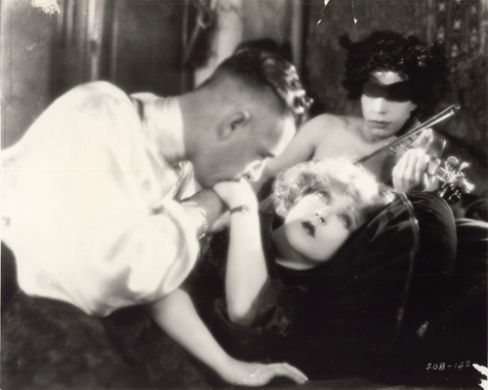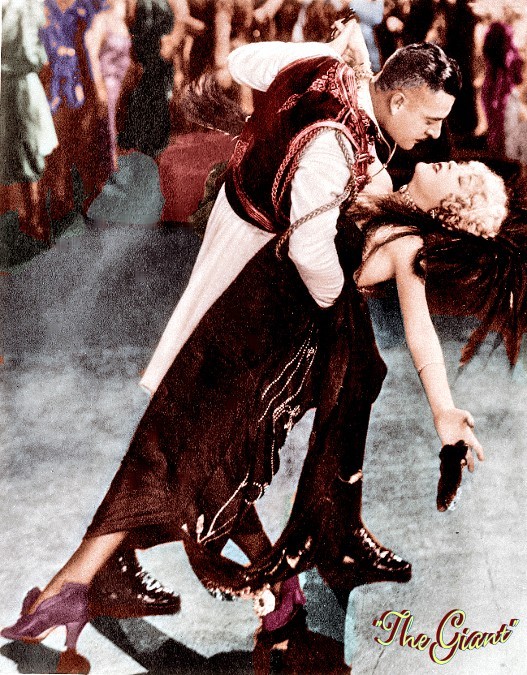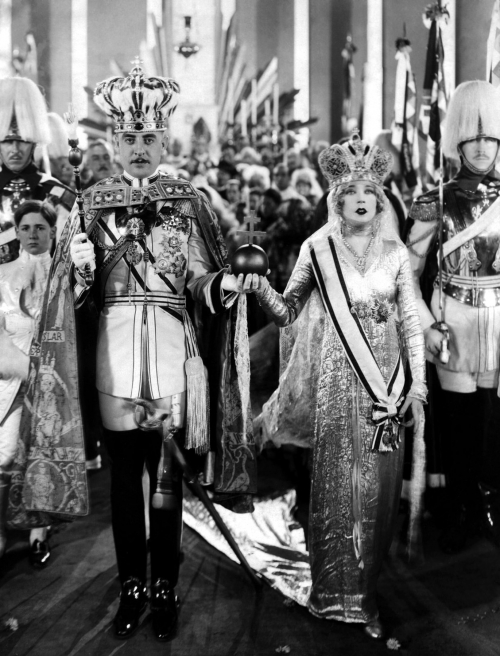Von Stroheim, Murray and Gilbert: Unconfined Joy!
DIRECTOR: ERICH VON STROHEIM/1925
This consideration of the 1925 film adaptation of the operetta THE MERRY WIDOW is the second in a series of Erich von Stroheim-centric pieces at ZekeFilm. Don’t miss the related pieces, found below.
 “Let joy be unconfined!” –Publicity tagline
“Let joy be unconfined!” –Publicity tagline
Mae Murray and John Gilbert team up for this tale of lust, love, and lavish costumes mixed with lovers’ machinations. Throw in a foot-fetishist baron played very creepily by Tully Marshall (who played similar roles in other movies, perhaps most notably the excised scenes from Queen Kelly, 1929) and you have a von Stroheim stew par excellence.
Irish vaudeville performer Sally O’Hara (who is ultimately disclosed to be the one whom the title references) finds her stage company stranded for the time being in Monteblanco, a fictitious kingdom somewhere in eastern Europe. Crown Prince Mirko (Roy D’Arcy) and Prince Danilo Petrovich (John Gilbert) are spending the night at the same inn and consequently try to win O’Hara’s affections. Both of them are sleazeballs, but the audience ends up rooting for Gilbert.

Nothing says “love” like a bed with blindfolded musicians.
Even though as a commoner O’Hara isn’t fit to be marriage material, all hope is not ultimately lost: she can marry the Baron who seems more interested in her feet in certain scenes than in her as a person. Fortunately for our heroine, the Baron keels over prior to anything being consummated, apparently because it’s been a great deal of time since his heart has beat quite that fast.
O’Hara does what any grieving widow in such a film would do: goes on a shopping spree in Europe, turning up in Paris. The princes hear of this and both go to win her affections since she’s now a Baroness and the one who has the rights to the Baron’s fortunes–the very fortunes on which the entire economy of Monteblanco depends. Petrovich shows up a little worse for the wear and dances the Merry Widow waltz with O’Hara (or should I say Baroness Sally Sadoja?) in a wonderful scene which to me evokes a bit of the most recent adaptation of Anna Karenina in terms of its focus on the couple as they dance.

Like any good fairy tale, they all live happily ever after. (I’m leaving out some details so that you’ll still have a reason to watch it, of course.)
A brief word on the version: the version I saw is available through the Warner Archive collection. My previous experience with organ scores were limited to the Gaylord Carter organ scores for Phantom of the Opera and Wings, which fall into a pit of busy-ness by which I’m disgusted. By contrast, The Merry Widow features a wonderful organ score by Dennis James who does a superb job using the might of the organ in the Fox Theatre in Atlanta, GA to make the screen come alive, using music from the popular operetta which audiences in 1925 would’ve understood and attributed to the story. And the music holds up just as well today, even though many today would only have a passing acquaintance with the Merry Widow Waltz, which James uses with discretion and at all the right moments. It is not restored, but is a well-preserved print. The final reel, originally in 2-tone technicolor has faded to black-and-white, even though the box still says “B&W with TECHNICOLOR Sequences.”
The Merry Widow is a von Stroheim picture which came in under budget and in an acceptable amount of time and featured a well-known actress (which Von usually avoided–he preferred unknowns who wouldn’t simple strut around the movie stage). It is far more commercial than something like Foolish Wives or Queen Kelly, but still manages to capture a great deal of the earthy blackness of people’s souls, even as they want to attract the attention of those whom they desire. The orgy scene was drastically cut down for the sake of censors and general propriety, but even in what remains, we see a director and cast who are not unfamiliar with the grotesqueness of desire-run-amok.

How many blindfolds did they actually use on this set?
Incidentally, this film is probably one of the two closest projects which gives us an idea as to what a completed Queen Kelly would look like. It’s far more tame than Kelly, but shows us how the virginal woman can interface with someone like D’Arcy or Marshall’s characters and not become fundamentally the same as them. I would maintain that Foolish Wives is probably the other project of the two, but since The Merry Widow is the only one of those two which was not cut down by the studio, it allows us to see a von Stroheim conception which is not shortened or mangled.
 Von Stroheim demonstrates the same sort of penchant for military display we see in other films such as Foolish Wives and Queen Kelly. In the introductions to various scenes, we see artillery and decoration medals on the garb of the characters. Everything is in its place, even down to the monacle that D’Arcy wears (presumably because his part was originally written to be played by von Stroheim, but the studio executives would have none of that). And yet, even amongst such organization, such filth oozes out of the hearts of the characters that it makes for an interesting study in contrasts–a study von Stroheim was to return to again and again in his characters and films.
Von Stroheim demonstrates the same sort of penchant for military display we see in other films such as Foolish Wives and Queen Kelly. In the introductions to various scenes, we see artillery and decoration medals on the garb of the characters. Everything is in its place, even down to the monacle that D’Arcy wears (presumably because his part was originally written to be played by von Stroheim, but the studio executives would have none of that). And yet, even amongst such organization, such filth oozes out of the hearts of the characters that it makes for an interesting study in contrasts–a study von Stroheim was to return to again and again in his characters and films.
The Merry Widow is an epic production lasting 2 hours and 17 minutes. Grab a glass of wine (but save it until the last reel) and settle in for a great evening.

